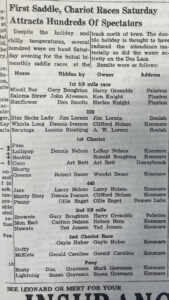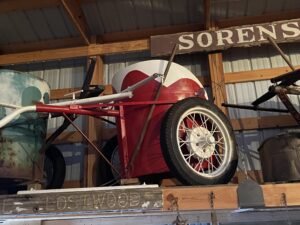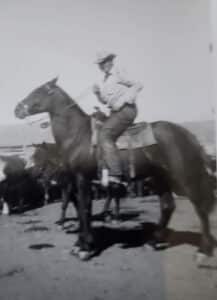Off to the Races: Remembering the Chariot Races in Kenmare

Pony races, ‘old school’ style from early 1960s. (left to right) Barb Kraft and unidentified riders. [Photo: submitted] (Photo shows time era from Berthold races: DHM is seeking photos of the Kenmare races)
A 55-gallon metal barrel, split and reconstructed with a custom welding and paint job attached to a hand-made hitch with front hubs and tires off a Model A car, was once pulled by a team of racehorses.
The racing chariot that beamed of blue and white colors drawn by horses brought excitement immersed with adrenaline to the crowds and fellow chariot racers to Kenmare, N.D. back in the 1960s.
It was the era of go-go boots, rock music, ‘the twist,’ and was a snippet in time when kids could play and ride their bikes on the streets past dark. The early ‘60s also consisted of a time when most farmers across the plains owned a horse or two and partook in ‘old fashioned fun’ such as chariot, saddle, and pony racing, which is now a part of history.
The wistfulness of pony, saddle, and chariot racing in the Honker country of Kenmare began around this time. Walt Thompson (who has passed) was once a highway patrolman for the area, and some locals built the racetrack on his property along the road going to the present day Kenmare golf course. “It’s all farmland now. No one would be able to recognize it was once home to wooden grandstands, an announcer that yelled, ‘go,’ and chariots high loping their horses in their final strides around the track,” smiled Ron Boughton, Kenmare.

Nelson Brothers chariot on display at the Pioneer Village, Kenmare. [Photo: D. Huff]
People organized the races using rotary dial telephones hooked to the wall. Things like touch screens, facetime, and call waiting were still a things of the future, unimagined by most. Summer Saturday evenings or Sunday afternoons brought neighborhood horse races, locals, and out of town folk from communities such as Berthold, Carpio, Flaxton, Sherwood, Mohall, and Bowbells to the small town of Kenmare.

Kenmare News clipping from 1965 in regard to the saddle and chariot races. [Courtesy: The Kenmare News]
“Three of us chariots would race at a time. There was probably 4 to 5 different ‘heats’ you would call it each race. They would have pony races for the kids, saddle horse races if people thought they had a fast horse, and rawhide races. Someone would get on a cow hide or even buffalo hide and were pulled at full speed behind a horse. Winner was who crossed the finish line first and intact,” explained Boughton.

The Boughton/Bott chariot that was once blue/white, now red/white on display at the Pioneer Village, Kenmare. [Photo: D. Huff]
Boughton said that his chariot racing times began with his then father-in-law, Art Bott, “We hand built and welded our own chariot. My friend worked for John Deere at the time and had access to a body shop, so one night he put a professional paint job on it. Art had some driving harnesses we used, and later we found some lighter driving harnesses to race. He had a bay horse, and I had a bay horse named Duke — together we had a team. They weren’t anything spectacular, but they made a good pair, and we had some wins and surely some good fun racing them.”
Boughton shared that bragging rights and some trophies, ribbons, and maybe a few bucks were the winning prizes. “I remember we put the little bit of money we won in a sledge fund in the bank in Kenmare. We had enough money to buy some brand-new blankets for our team. We needed those, because racing into the dusk of night, the blankets helped dry and take care of the horses.”
The chariot teamster also noted that his team was loaded in the bed of a tonner pickup, and they hauled the chariot with a special hitch made for the backside of the truck. No fancy trucks or trailers were used for this historic endeavor — it was hand-built ingenuity that transported the team, carriage, and handlers to and from.
Reminiscing about the times, Dean Meyer, Dickinson, said that he recalled the unique running start. “The chariot teams would start walking and trotting around the track, and once they were approaching start line, that flagger would drop a flag and announcer called the race on. The track was three-eighths to half a mile long, and everyone would hug the rail, so there was some good watching and a few wrecks.”
“My Grandpa Herb was so proud. He always said, ‘Whatever you do, don’t let go of the lines (reins) of your team.’ Grandpa came in the house one day covered in flax crop, face all scratched up, but with a big grin and said, ‘I never let go of the reins and they stopped — eventually,” Meyer said. He said his grandpa, Herb Birdsall, and dad, Darrel Meyer, both of Berthold, loved raising and training their own horses for this.

Darrel Meyer pictured with the hauling truck they used to transport racehorses to Kenmare and back to Berthold. [Photo: courtesy of Gayle Hanna]
Meyer said he was in more riding shape back then and raced his grandpa’s home-raised thoroughbred horses and that Jack Brown of Berthold had a big thoroughbred too, so he got to jockey a couple. “We would back our pickups into a ditch to have kind of a ramp and load all those racehorses in the bed of the trucks, pull the chariot on back, and head to the races; my dad and grandpa hand-built their chariot at the Millard Ohnell shop in Berthold back in the day.”

Herb Birdsall atop one of his home-raised racehorses, early 1960s. [Photo: submitted]
“We would drive our team during the week to keep them in shape. Sometimes it was slow and at a walk or trot on the track and then galloping them in the fields to keep their endurance up,” said Boughton. The slow work could be compared to the ‘dry work’ that barrel racers do on and off the pattern during the week.
The same was true of the Birdsall/Meyer horses. “Herb had a track plowed in one of the fields and would train on that. They started the chariot horses on a big pole and center spindle kind of like a walker and harnessed them up all day to beginning their training process,” added Meyer.
Three or four streaking teams racing down the track was no place for a weakling. “Competition eventually got pretty fierce,” said Boughton. “Some members started outsourcing higher powered horses and were dead set on ‘the win,’ but I remember the comradeship and the good, clean fun the races could offer everyone.”

Kenmare News clipping from 1965, referencing winners of saddle, pony, and chariot races. [Courtesy: the Kenmare News]
Darol Jeffrey, Berthold, said that he and his father, Neil, both had a team. “We used our saddle horses and trained them for the chariot races. Our horses got to be in such good racing condition and looked forward to the races as much as we did. I remember getting ready to leave one race, and they were tied to the box of the truck we loaded them in. Someone stopped to visit, and those horses started pawing. They were ready to go and would jump themselves in the bed of the truck,” Jeffrey recalled the huge crowds and that everyone involved had a lot of fun.
“I was 5 years old, and we would look forward to the Kenmare Chariot races all week. Come Saturday my cousin, Lynn Meyer, and his Welsh pony along with my pony ‘Princess’ would get loaded with the chariot horses. Driving from Berthold on those warm summer evenings, it was exhilarating; you would look to the right and see the white numbers (class of) set in the green hillside of the Kenmare landscape. The bleachers were white. The crowd was excited as we would watch the chariot racers come and go by. I entered the pony races. Lynn entered the Welsh pony races. It was happiness driving back to Berthold in the dark,” said Barb Kraft of Berthold.
The Kenmare chariot races captured the hearts of many competitors, horses, and on-lookers. Much like Secretariat and Sea Biscuit, iconic racehorses amidst American history, the chariot races in Kenmare may have touched fewer individuals. However, each memory was just as positively uplifting and radiant. Taking the summer nights in with massive strides, the forerunners of Dakota horses and its people represented brevity, ingenuity, and an undenied ‘need for speed.’
To see some of the chariots on display that once ran at the races, visit the Pioneer Village in Kenmare.
*Please note, photos were not as abundant in the 1960s as present day. If anyone has some from this time era relating to the Kenmare horse races, please reach out to Dakota Horse Magazine, we would love to share them.

Tisa Peek is a long-time horse trainer, competitor in barrel racing and team roping, and writer about the equine. Rodeo and horses run deep in her roots. JT Family Equine is where she calls home, south of Bismarck, ND. Tisa, along with her husband, Jon, and boys, Blu and River, train horses and host clinics. Tisa is the host for Dakota Cowboy on BEK TV.
